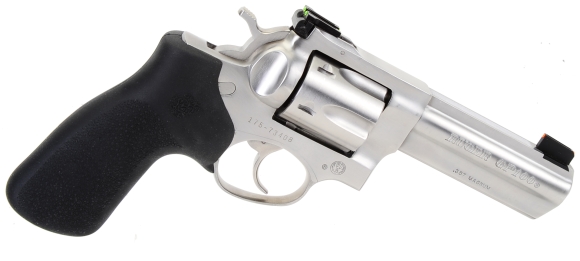
 I have to say, this has become a messy project and one that has not been particularly satisfying in the efforts I put forth and the results I’ve achieved. The Ruger GP100 and Ruger Model 77/357 have tolerated my missteps and experiments without complaint. To the end they remain tight, accurate and reliable.
I have to say, this has become a messy project and one that has not been particularly satisfying in the efforts I put forth and the results I’ve achieved. The Ruger GP100 and Ruger Model 77/357 have tolerated my missteps and experiments without complaint. To the end they remain tight, accurate and reliable.
So lets briefly review the tests, results and progress to date…
Ballistic Gel tests as conducted previously are irrelevant in regard to the Model 77/357 carbine and selected bullet performance and integrity. Shooting into a blob of jello at the prescribed 10′ with a rife is reflective of no real world circumstance. Just doubling the distance to 20′ and reshooting the same ammunition from Part II yielded approximately 10% greater penetration, much improved bullet weight retention and no jacket failures.At some point in time, I will reshoot the ballistic gel tests with the carbine at 50 yards and 100 yards, more typical shooting distances.
Velocity, kinetic energy and trajectory for Part II bullets were good, however, I did want to source a soft point 158 grain jacketed bullet and a hard cast bullet that the Ruger would shoot accurately. The 158 grain hard cast in Part II did not demonstrate reasonable accuracy when shot from the carbine, but it did well with the revolver. My guess is a short shank and semi wad cutter nose contributed to the bullet’s 100 yard carbine inaccuracy.
Three bullet types were tried as handloads. Left to rights: MagTech 158 grain Jacketed Soft Point, Hunters Supply 158 grain Pentagon Hollow Point and Hunters Supply 190 grain 190 grain Flat Point.
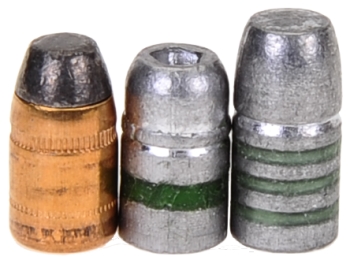
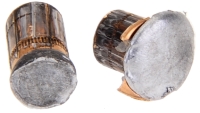 The MagTech bullet is listed by the manufacturer for target and hunting application. Shot from the Ruger GP 100 it generated 1362 fps of muzzle velocity, 1871 fps from the Model 77. Ballistic gel penetration was 24″ for the GP100 and 20″ for the Model 77. The greater penetration at lower revolver velocity was due to lesser bullet expansion, 0.390″ diameter for the short barrel gun and 0.620″ for the carbine. As a common bullet for both guns, it came in second for me. The handload is:
The MagTech bullet is listed by the manufacturer for target and hunting application. Shot from the Ruger GP 100 it generated 1362 fps of muzzle velocity, 1871 fps from the Model 77. Ballistic gel penetration was 24″ for the GP100 and 20″ for the Model 77. The greater penetration at lower revolver velocity was due to lesser bullet expansion, 0.390″ diameter for the short barrel gun and 0.620″ for the carbine. As a common bullet for both guns, it came in second for me. The handload is:
Bullet: MagTech 158 Grain JSP
COL: 1.540″
Powder Charge: 15.3 Grain L’il Gun
Primer: CCI 500
 The Hunters Supply 158 grain Pentagon Hollow Point is listed by the manufacturer with a Brinell Hardness of 16, the same as the company’s 190 grain flat nose bullet. The Pentagon Hollow Point is defined as an expanding bullet with a velocity range of 700 fps to 1600, for use on small, medium and large game. With a revolver muzzle velocity of 1381 fps, ballistic gel penetration was 42″, with an expanded diameter of 0.450″ and a retained weight of only 52 grains.
The Hunters Supply 158 grain Pentagon Hollow Point is listed by the manufacturer with a Brinell Hardness of 16, the same as the company’s 190 grain flat nose bullet. The Pentagon Hollow Point is defined as an expanding bullet with a velocity range of 700 fps to 1600, for use on small, medium and large game. With a revolver muzzle velocity of 1381 fps, ballistic gel penetration was 42″, with an expanded diameter of 0.450″ and a retained weight of only 52 grains.
At a rifle muzzle velocity pf 1877 fps there was no bullet to recover, just a trail of small lead shards lining a bullet hole. The gel impact was impressive with three 16″x6″x6″ blocks bouncing around like flubber… and knocked them off the bench. Hunters Supply 190 grain flat nose did not expand to any significant degree and penetrated an impressive 40″ @ 1351 fps revolver velocity and 52″ @ 1698 fps carbine velocity. The 158 grain bullet put up 3 shot, 100 yard groups of 2 1/2″ to 3″, the 190 grain shot 1 1/4″ or less. The handload details are:
Bullet: Hunters Supply 158 Grain PHP
COL: 1.550″
Powder Charge: 15.3 Grains L’il Gun
Primer: CCI 500
Bullet: Hunters Supply 190 Grain FP
COL: 1.590″
Powder Charge: 14.4 Grains L’il Gun
Primer: CCI 500
Lead hardness… A little checking to understand the difference in results?
 The Hunters Supply 158 grain PHP failure was puzzler. Hard lead alloys have a different look and feel than soft alloys. Hard alloy has a tighter texture, usually more sharply defined edges and tapers and they have a duller sheen. If an alloy is soft enough, a thumb nail is hard enough to score the surface.
The Hunters Supply 158 grain PHP failure was puzzler. Hard lead alloys have a different look and feel than soft alloys. Hard alloy has a tighter texture, usually more sharply defined edges and tapers and they have a duller sheen. If an alloy is soft enough, a thumb nail is hard enough to score the surface.
Since the 158 grain, far left, shed so much weight and flattened, and the 190 grain stayed together retaining virtually all of its weight and form, it seemed obvious that one was soft and one was hard even if both are listed at 16 BHN (Brinell Hardness Number).
In a lead hardness testing to assign a BHN, a steel ball (indenter) is pressed into the lead alloy under a constant load, and for a set time. The resulting indentation made my the steel ball into the lead surface is measured and interpreted into hardness. The deeper the indentation, the lower the BHN, the softer the material. A commercial digital Brinell hardness tester that would apply to this size object, this type of material and this Brinell falls into a $5,000 to $25,000 price range.The price spread dependent upon how exactingly the load to the indenter is applied load is and the sophistication of method used to read the size of the resulting indentation.

There are portable electromagnet and load cell monitored Brinell testers in the $600 to $1,800 price range, but as a practical matter they are no more accurate than the Lee Lead Hardness Tester, $67 at shooting sports online discount retailers. The Lee Hardness Tester, covered in details and broken down to piece parts was covered previously on Real Guns, “The Lee Lead Hardness Testing Kit and Other Bullet Biting Alternatives“.
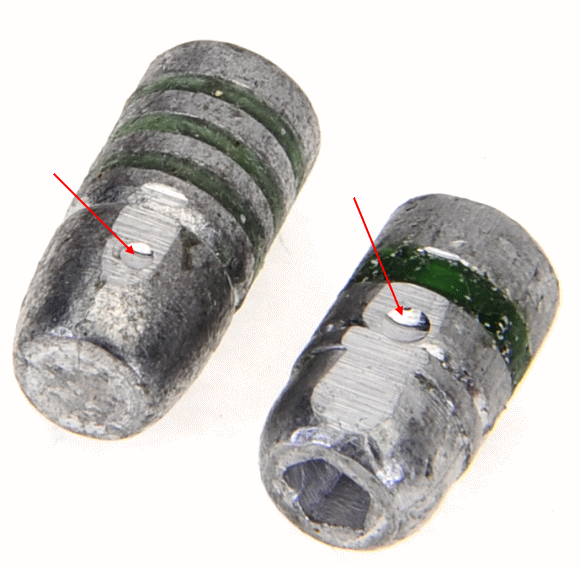
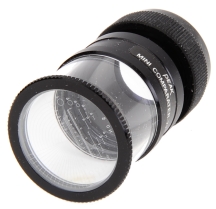 Above, the two sample bullets with indenter marks to be measured. The only component of the Lee Lead Hardness Testing Kit that drove me a little crazy was the included scaled microscope. It is hard to work with and erroneous measurement of indentations is the leading cause of Brinell inaccuracy. So I replace it with my 7x comparater with a No. 5 reticle.
Above, the two sample bullets with indenter marks to be measured. The only component of the Lee Lead Hardness Testing Kit that drove me a little crazy was the included scaled microscope. It is hard to work with and erroneous measurement of indentations is the leading cause of Brinell inaccuracy. So I replace it with my 7x comparater with a No. 5 reticle.
A flat must be filed on the bullet so the indenter will meet a flat surface and crater uniformly. This might alter the hardness of a tempered cast bullet, but the indication is for alloy hardness, not surface hardness. The bullet, above left, indentation measures 0.058″ which equates on the kit’s chart to 15.4 BHN. The bullet indentation, above right, measures 0.078″ which equates to a BHN of 8.2.
The 190 grain bullet hard alloy is roughly the equivalent of Lyman #2 alloy; 90% lead, 5% antimony and 5% tin. The 158 grain soft alloy is similar to 97% lead and 3% tin, which solves the mystery of why the Hunters Supply 158 grain bullets performed so poorly and the 190 grain did so well.
Final picks for common Ruger GP 100 and Ruger Model 77/357 ammunition…
I realize the information may seem a bit wandering but, honestly, that’s how projects often go when much of the motivation is enthusiasm for firearm. You try something, stumble upon something of unexpected interest and follow that to a conclusion. It is very easy with a cartridge like the 357 Mag to pick an acceptable type of ammo and just stick with it, but then all of the other potential, good and bad, would be missed.
With warmer weather on the way, and lots of shooting days ahead, I’m going to build experience with Remington HTP 158 grain and 180 grain jacketed hollow point, MagTech 158 grain jacketed soft point handloads, and Hunters Supply 190 grain hard cast handloads. at the end of summer, the choice for deer hunting should be clear. Who knows? I might not be any of the ammunition listed so far. The more I shoot the Ruger GP100 and the Ruger Model 77/357, the more I can appreciate them for the job they do and enjoy shooting them. Two excellent firearms with a great deal of utility, offering lots of opportunity for the 357 Mag.
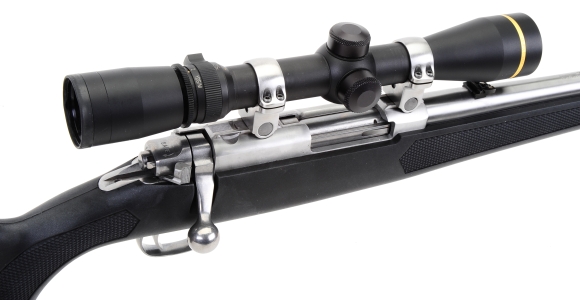
Email questions and comments regarding this article to: Editor@RealGuns.Com

Email Notification